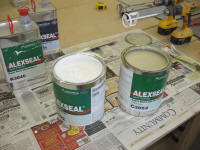
| Kaholee Refit |
February 3, 2007 The final step before shooting the first coats of primer this morning was to solvent wash the decks with the appropriate surface cleaner--in this case, Alexseal Surface Cleaner. Using two rags--one to apply the solvent and the other to wipe down behind--I cleaned the entire deck. Then, I used a tack cloth to remove any final bits of dust. |
 Because
it was impossible to reach all areas of the deck from the staging
alongside, I knew I'd have to spray the coachroof first, leaving the
sidedecks and other areas alone until I had applied the three coats to
the top areas. This necessarily extended the overall length of the
process, since the painting would occur in essentially two distinct
operations. Since this was only primer, I wasn't worried about the
possibility of any lap marks between the two areas. Because
it was impossible to reach all areas of the deck from the staging
alongside, I knew I'd have to spray the coachroof first, leaving the
sidedecks and other areas alone until I had applied the three coats to
the top areas. This necessarily extended the overall length of the
process, since the painting would occur in essentially two distinct
operations. Since this was only primer, I wasn't worried about the
possibility of any lap marks between the two areas.
Because of the extent of repairs and fairing, and the general age of the boat, I chose to begin with three coats of high build primer to homogenize the surface textures and to help fill minor cracks and pinholes. In addition, the high build primer step would allow me one final chance to fill and fair selective areas as required before applying finishing primer, and would help ensure that the finishing primer was as even and consistent a coat as possible. I selected Alexseal 302 Super Build primer for these first coats. |
Over the next four hours, I applied three coats of primer first to the top of the cabin trunk (coachroof), leaving the sidedecks alone so that I could kneel up on the deck off the staging and reach the centermost areas, and then the remaining decks. I was able to reach the inside of the cockpit well--with difficulty--from the staging, though even as I began the first coat here I knew that I 'd approach it differently when it came time for finishing primer in a few days, and particularly when I shot the topcoats. But that's for another time. The most challenging part of spraying a deck like this is keeping the hoses out of the way, away from the fresh paint, and to avoid them becoming hopelessly tangled. My spray gun used a 1" diameter air hose, in addition to the air hose leading to my supplied air mask. An ideal situation might be to have these hoses somehow suspended from the ceiling, perhaps along the lines of the rotating brackets found at those car wash bays. As always, I found that I modified my technique with each coat, and found a way to better handle the hoses. Complicating everything, of course, was the need to refill the reservoir on the spray gun; I needed two refill stops per coat. This meant I had to untangle the hoses enough to be able to move down the staging from wherever I was, descend the ladder, and get into the wood shop bay behind the boat in order to refill my gun. If nothing else, the extra coats of primer are good for sheer spraying and material handling practice! The first coats of primer always offer a satisfying release. The transformation from a patched-up, multi-colored apparition to a smooth, uniform, cleanly-primed surface is dramatic, and provides a necessary sense of accomplishment after a long road of grinding, filling, fairing, and sanding. |
|